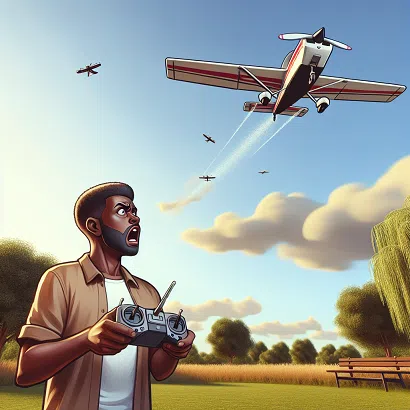
Table of Contents
Ever dreamed of piloting your own aircraft? While a pilot’s license might cost upwards of $10,000, you can experience the thrill of flight for under $200 with an RC airplane.
However, choosing your first RC airplane can feel overwhelming. With hundreds of models available and technical terms like “aileron control” and “pitch stability,” many beginners make costly mistakes by picking the wrong aircraft. In fact, 70% of new RC pilots crash their first RC airplane within the first few flights because they chose an aircraft that was too advanced.
Finding your first RC airplane for beginners doesn’t have to be complicated. Whether you’re looking to fly for fun or planning to develop serious RC piloting skills, this guide will walk you through exactly how to choose your first RC airplane. Let’s help you get airborne with confidence!

Understanding RC Airplane Basics
Initially, understanding the basic components and controls of an RC airplane is crucial for successful flight. Let’s break down these fundamentals to help you make an informed choice for your first RC airplane.
Key Components of an RC Plane
A basic RC airplane consists of several essential parts working together:
- Transmitter (TX): Your handheld controller that sends signals to the plane
- Receiver (RX): Receives signals from the transmitter and controls plane components
- Servos: Small motors that move control surfaces based on your inputs
- Motor: Provides thrust through the propeller
- Battery: Typically a LiPo (Lithium Polymer) battery that powers the aircraft
- Control Surfaces: Including elevators, rudders, and ailerons
Different Types of RC Planes
Specifically, beginners should focus on trainer aircraft, which offer more forgiving flight characteristics. These planes typically feature a high-wing design that keeps the center of gravity lower, providing greater stability during flight. Additionally, most modern trainer planes come equipped with flight-assisted technologies, such as SAFE (Sensor Assisted Flight Technology), making the learning process considerably easier.
Control Systems Explained
Understanding the control system is fundamental to mastering RC flight. Most beginner first RC airplane use either a 3-channel or 4-channel setup:
| Channel Type | Controls |
|---|---|
| 3-Channel | Throttle, Rudder, Elevator |
| 4-Channel | Throttle, Rudder, Elevator, Ailerons |
Furthermore, modern RC transmitters operate on 2.4GHz frequency with frequency hopping technology, ensuring reliable control without interference from other pilots. The control surfaces respond directly to your transmitter stick movements, allowing precise control of the aircraft’s movement in all directions.
For first-time pilots, a plane with SAFE technology offers additional protection, as it includes features like automatic leveling and “panic recovery” mode, which can return the aircraft to level flight when activated.
Choosing Your First RC Airplane
Selecting the right training aircraft significantly impacts your success in RC flying. Let’s explore the key factors that make certain planes ideal for beginners.
High-Wing vs Low-Wing Designs
For novice pilots, the position of the wings plays a crucial role in flight stability. A high-wing trainer offers natural stability since the aircraft’s weight sits below the wings. Essentially, this design works like a pendulum, helping the plane self-correct during flight. Rather than requiring constant adjustments, a high-wing trainer will naturally return to level flight if you release the controls.
| Design Feature | High-Wing | Low-Wing |
|---|---|---|
| Stability | Self-correcting | Less stable |
| Learning Curve | Gentle | Steeper |
| Wind Response | More forgiving | More sensitive |
Electric vs Fuel-Powered Options
Electric-powered planes have become the preferred choice for beginners. Accordingly, these aircraft offer several advantages:
- Simpler operation with no fuel maintenance
- Quieter flight suitable for more locations
- Lower ongoing costs with rechargeable batteries
- Faster setup time from unpacking to flying
Generally, fuel-powered planes provide longer flight times and more power. Nevertheless, they require more maintenance, have higher operating costs, and need specialized flying locations due to noise considerations.
Size and Weight Considerations
The size of your first RC airplane significantly affects its flight characteristics. For beginners, these guidelines help ensure manageable flight characteristics:
- Wingspan Recommendations:
- 50-80 cm: Suitable for park flying and basic training
- 80-140 cm: Ideal for developing intermediate skills
- Weight Factors:
- Lighter planes are more forgiving and break less often
- For trainers under 36-inch wingspan, a 24-gram motor provides adequate thrust
- Consider using 2S or 3S batteries for optimal power-to-weight ratio
A stable trainer aircraft should feature enough wing area to maintain lift at slower speeds, consequently giving you more time to react and learn the controls. The combination of appropriate size and weight ensures your first RC airplane remains manageable as you develop your piloting skills.
Essential Features for Beginners
Modern technology has transformed the way beginners learn to fly RC aircraft. Let’s explore the essential features that make certain models ideal for new pilots.
Stability Systems and Assistance
Today’s RC trainers come equipped with sophisticated stability systems that make learning significantly easier. The most notable advancement is SAFE (Sensor Assisted Flight Envelope) technology, which offers three distinct modes:
- Beginner Mode: Limits pitch and roll angles with self-leveling
- Intermediate Mode: Increased control with some restrictions
- Experienced Mode: Full manual control
Moreover, these electronic stabilization systems use MEMS (micro-electromechanical systems) sensors to measure changes in motion and position. This technology helps prevent common beginner mistakes by automatically correcting unstable flight conditions.
Number of Channels Needed
For your first RC airplane, the number of channels directly impacts your learning experience. Here’s a practical breakdown:
| Channel Count | Controls | Best For |
|---|---|---|
| 3 Channels | Throttle, Elevator, Rudder | Basic training |
| 4 Channels | Above + Ailerons | Complete control |
While 3-channel aircraft are easier to operate, a 4-channel plane provides superior control options for long-term skill development. The additional aileron control enables more precise turning and helps develop proper flying techniques that will benefit your progression in the hobby.
Durability Factors
Overall, the durability of your first RC airplane can make the difference between a successful learning experience and premature frustration. The most resilient trainers feature:
- Construction Materials:
- Advanced EPO foam for impact resistance
- Reinforced wing struts for structural integrity
- Patented metal landing gear for rough landings
Besides the material choice, modern trainers incorporate oversized wheels for better shock absorption and enhanced ground handling. These features enable the aircraft to endure the inevitable challenges of learning.
Certainly, the combination of stability assists, appropriate channel configuration, and durable construction creates an ideal platform for mastering RC flight basics. When selecting your first RC airplane, prioritize models that incorporate these essential features to ensure a positive learning experience.
Budget Planning and Investment
Proper budget planning ensures you start your first RC airplane journey without unexpected expenses. Let’s examine the realistic costs of getting into RC aircraft flying.
Initial Purchase Costs
The basic investment for your first RC airplane varies based on your chosen setup. Primarily, a complete beginner’s package ranges from $400 to $600 for quality equipment. This typically includes:
- Basic radio system
- Decent .40 size engine
- Standard trainer aircraft
- Essential assembly materials
A more economical approach can get you airborne for around $200, though this may limit your options. Notably, many beginners overlook that most models don’t include all necessary components, requiring separate purchases for items like covers, wheels, and fuel tanks.
Additional Equipment Needed
Beyond your first RC airplane itself, several essential items contribute to your total investment:
| Equipment Category | Approximate Cost Range |
|---|---|
| Field Equipment | $30-150 |
| Basic Tools | $100 |
| Safety Gear | $50-100 |
Essential field equipment includes:
- Manual fuel pump
- Field box
- Glow igniter
- Basic repair tools
- Storage containers
Long-term Maintenance Expenses
Ultimately, the ongoing costs of RC flying extend beyond your initial investment. Annual expenses typically include:
- Club Memberships:
- Academy of Model Aeronautics (AMA) membership
- Local club dues
- One-time runway fees
- Regular Maintenance:
- Replacement parts
- Battery upgrades
- Repair materials
- Fuel or battery costs
Particularly worth noting, experienced pilots often spend between $500 and $1,000 annually on maintenance and upgrades. First-year costs can be higher, with many enthusiasts investing approximately $2,500 as they build their collection of tools and spare parts.
Remember that starting with basic equipment and gradually upgrading as your skills improve is often more cost-effective than investing in premium gear immediately. This approach allows you to understand what features you truly need before making larger investments.
Where to Buy Your First RC Airplane
Choosing where to purchase your first RC airplane can substantially impact your learning experience. Let’s explore your options and what to consider when selecting a retailer.
Local Hobby Shops vs Online Retailers
The debate between local hobby shops and online retailers centers around service quality and convenience. Indeed, local hobby shops offer unique advantages:
- Face-to-face expert guidance
- Immediate product availability
- Hands-on product inspection
- Building community connections
As opposed to this, online retailers typically provide:
| Aspect | Online Benefits |
|---|---|
| Pricing | Often lower due to reduced overhead |
| Selection | Broader product range |
| Availability | 24/7 shopping convenience |
| Shipping | Direct delivery to your door |
Notably, many RC enthusiasts recommend visiting local hobby shops first, as the personalized guidance can prove invaluable for beginners. Similarly, some local shops now offer online price matching and ordering services to stay competitive.
What to Look for in a Seller
When evaluating potential sellers, consider these crucial factors:
- Expertise Level:
- Staff knowledge of RC aircraft
- Ability to provide technical support
- Track record in the RC community
- Product Range:
- Stock of beginner-friendly aircraft
- Availability of replacement parts
- Quality of brands carried
In light of recent market changes, many successful retailers have adapted by combining physical stores with online presence. Ultimately, the best sellers maintain strong customer support regardless of their platform.
Warranty and Support Options
Understanding warranty coverage is essential for protecting your investment. Major manufacturers like Horizon Hobby offer these standard protections:
- Manufacturer defect coverage
- Technical support access
- Replacement parts availability
For warranty service, consider these key points:
- Coverage Duration:
- Most manufacturers offer 90-day warranties
- Some provide extended coverage options
- Certain components may have separate warranty terms
- Service Requirements:
- Original proof of purchase needed
- Proper documentation of issues
- Compliance with maintenance guidelines
- Support Channels:
- Phone support availability
- Email response times
- Online resources access
Moreover, warranty terms vary significantly between retailers. For instance, some online sellers offer limited warranties solely for manufacturing defects, whereas others provide comprehensive coverage, including shipping protection.
Remember that many local hobby shops provide additional support beyond manufacturer warranties, offering repair services and technical guidance that can prove invaluable for beginners. Correspondingly, reputable online retailers often maintain dedicated support teams and extensive knowledge bases to assist customers.
LOOK FOR YOUR FIRST RC AIRPLANE HERE
Conclusion
Selecting your first RC airplane marks an exciting step into the world of remote-controlled flight. Rather than rushing into an expensive or complex model, smart beginners focus on trainer aircraft with stability features like SAFE technology.
Success in RC flying depends largely on making informed choices about aircraft type, essential features, and where to buy. High-wing trainers equipped with modern stability systems offer the best foundation for learning, while proper budgeting ensures you have all necessary equipment and support.
Remember that your first RC airplane serves as a learning platform. Though crashes might happen, choosing a durable trainer aircraft from a reputable seller helps protect your investment. Armed with this knowledge, you can confidently begin your RC flying journey and develop the skills needed for more advanced aircraft down the line.


